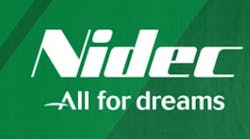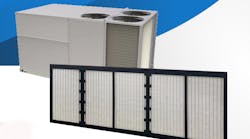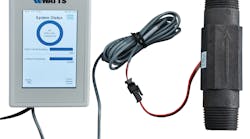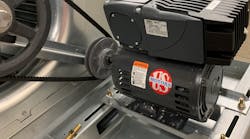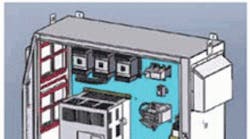Variable-frequency drives (VFDs) and similar heat-producing electronic and electrical equipment can be housed in a variety of NEMA-rated enclosures. For outdoor installations, the most common types are NEMA 3R and NEMA 4X stainless steel. Certain types of fiberglass enclosures are rated NEMA 4X, but generally are not suitable for housing heat-producing equipment.
While the NEMA Website defines each type of enclosure, interpretation is needed to determine which enclosure is best for a particular application. Additionally, enclosures typically are modified by suppliers to fit a particular application, and those modifications must be evaluated as well. Lastly, certain options, such as enclosure-cooling systems, generally are required for VFDs and similar equipment, and these options become part of the enclosure system and, thus, part of the evaluation process.
This article will focus on whether to use a NEMA 3R or NEMA 4X enclosure for outdoor VFD applications. The factors discussed can be applied to outdoor installations of other heat-producing electronic and electrical equipment.
Will NEMA 3R Work?
For outdoor VFD applications, a NEMA 3R carbon-steel enclosure with white powder-coated paint typically is specified. The white color helps to reflect sunlight and keep interior temperatures relatively low, while the powder-coated paint protects the steel from rust and the elements.
A NEMA 3R enclosure typically is supplied with thermostatically controlled fans. The air intakes of the fans are equipped with filters. As the fans pull in outside air and exhaust internal air, internal enclosure temperature is kept reasonably close to ambient. Adding fans can increase the ambient-temperature rating from the typical 40°C (104°F) to 50°C (122°F).
The filters generally are rated from 20 to 30 ppm and keep dust, dirt, and insects from entering the enclosure. Steel guards/louvers cover the fan and vent openings. This is necessary to keep out rodents and other small animals seeking heat in colder climates.
The fans generally are mounted on the bottom of the enclosure and draw ambient air up into the enclosure and out of the side (Figure 1). A shroud for deflecting exhausted air downward is recommended. Both the inlet and exhaust openings face downward to eliminate blowing and/or falling precipitation from entering the enclosure.
The bottom of the enclosure often includes a crimped edge, which is used as a drip end, forcing moisture to fall off the enclosure, rather than run along the bottom and get drawn up into the enclosure by the fans.
The door opening also includes a drip edge to shed moisture to the side (Figure 2). The door gasket mates with the drip edge, making an airtight seal to keep moisture, dust, and dirt out of the enclosure. Lift-off door hinges with brass pins provide better security and weather protection and easier access than piano hinges (Figure 3).
For VFDs and similar equipment, a window often is installed in the enclosure front to allow viewing of internally mounted components. This window generally is a hard-coated waterproof polyester film providing ultraviolet (UV) protection from the sun. UV protection increases resistance to film yellowing and prevents premature embrittlement.
Where standing water and flooding are potential issues, NEMA 3R enclosures can be wall-mounted, if the VFD and heat sink are mounted inside of the enclosure. Internal heat-sink mounting was not possible in the past; newer VFDs, however, produce less heat, making this a viable alternative. With adequate ventilation and airflow, it is possible to have an internal heat sink and still achieve desired ambient temperature. Mounting the heat sink internally, as opposed to externally, allows for a simplified flat-back enclosure design, enabling a host of simple mounting options.
An external heat sink typically is mounted on the rear of a NEMA 3R enclosure and covered with a steel shroud. Fans are added to blow air across the heat sink, and the enclosure typically is supported by mounting feet (Figure 4). Mounting feet commonly are used in remote applications with no wall for mounting an enclosure and in large VFD applications in which a heat sink must be external to an enclosure.
The advantages of NEMA 3R enclosures for outdoor VFD applications include relatively low cost—up to 300-percent less than the cost of a NEMA 4X stainless-steel enclosure. The cost savings are attributed to the lower cost of the enclosure itself, as well as the use of fans instead of an air conditioner.
Another advantage of NEMA 3R enclosures is simpler installation, as it is easier to connect conduit to a vented carbon-steel enclosure than to a sealed stainless-steel enclosure. Also, operation and maintenance costs are lower with a NEMA 3R enclosure, as a fan is cheaper to run, repair, and replace than an air conditioner.
NEMA 3R enclosures have two distinct disadvantages when compared with NEMA 4X enclosures. First, there is no protection against corrosive environments, such as those found seaside and under cooling towers. Second, NEMA 3R enclosures cannot protect against water spay in washdown environments, such as those found in many food, beverage, and pharmaceutical plants.
Typical applications for NEMA 3R enclosures include rooftop air-handling units and exhaust fans, irrigation pumps, and water/wastewater pumps. Where NEMA 3R enclosures will not work, NEMA 4X is the preferred alternative.
NEMA 4X Fits the Bill
Stainless steel does not rust and is not affected by corrosive elements. It tends to reflect, rather than absorb, the sun’s rays, helping to lower internal enclosure temperature.
Because a NEMA 4X enclosure is sealed, fans and filters cannot be used for cooling. Instead, internal enclosure temperature is controlled by either oversizing the enclosure or conditioning the air (Photo A). In either case, the ambient-temperature rating typically is 40°C (104°F).
Oversizing an enclosure often is the best option when the amount of heat generated by internally mounted components is relatively low. However, the price of a NEMA 4X enclosure increases rapidly with size, making air conditioning the lower-cost option in many cases. In some instances, both a larger enclosure and an air conditioner are required to meet heat-dissipation requirements.
The door openings, gaskets, and windows of NEMA 4X enclosures are similar to those of NEMA 3R enclosures. Stainless-steel or brass hinges often are used for long-lasting protection from corrosion and rust.
Like their NEMA 3R counterparts, NEMA 4X enclosures cannot be submersed and, thus, generally are wall-mounted or floor-mounted on stands in environments with the possibility of standing water. For larger enclosures and air-conditioning systems, floor mounting on stands often is the best option.
NEMA 4X stainless-steel enclosures are suitable for most, if not all, applications for which extreme moisture and corrosive elements are a concern. The main disadvantages as compared with NEMA 3R enclosures are higher first cost, more-complex installation, and higher operating and maintenance costs.
If a NEMA 4X enclosure is oversized to allow heat dissipation, then space may become an issue. If air conditioning is used instead, the total footprint likely will be larger than that of a comparable NEMA 3R enclosure with fans and filters.
Conclusion
Selecting the proper enclosure will save money over the life of a system. If a NEMA 3R enclosure is found to be suitable, then money will be saved in purchase, installation, operation, and maintenance costs. If a NEMA 3R enclosure is deemed unsuitable for a particular environment, then a NEMA 4X stainless-steel enclosure should fit the bill.
A building-automation application engineer for Yaskawa America Inc., Joe Koepke has more than a decade of experience in variable-frequency-drive technical support and application engineering. He has a bachelor’s degree in mechanical engineering from the Milwaukee School of Engineering.
Did you find this article useful? Send comments and suggestions to Executive Editor Scott Arnold at [email protected].



